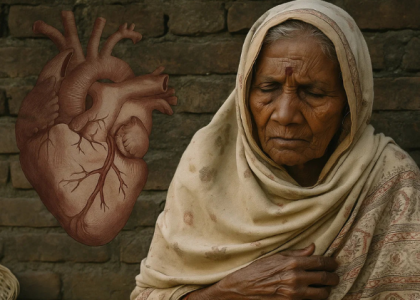“My cholesterol is normal, so my heart must be fine, right?” If you’re South Asian, the answer might surprise you. Many people in our community have heart attacks even with “good” cholesterol numbers. Why? Because regular cholesterol tests miss some of the biggest heart risks that affect South Asians.
Here are 5 hidden dangers your doctor might not be checking for – and what you can do about them.
1. Lipoprotein(a) – The Dangerous Cholesterol No One Checks
What is it? Lipoprotein(a), or Lp(a), is a special type of cholesterol that’s mostly controlled by your genes. Think of it as “super sticky” cholesterol that clogs your arteries much faster than regular cholesterol.
Why South Asians should worry: Studies show that 1 in 3 South Asians may have high Lp(a) levels – much higher than other groups. This can increase your heart attack risk even if your regular cholesterol looks perfect.
The scary part: Most doctors don’t test for Lp(a) unless you specifically ask. It doesn’t show up on regular cholesterol panels, so you could have dangerously high levels and never know it.
Did You Know?
Lp(a) is passed down from your parents. If one parent has high Lp(a), you have a 50% chance of having it too. Once you know your level, you only need to test once in your lifetime because it doesn’t change much.
What you can do: Ask your doctor for an Lp(a) test. If it’s high (over 30 mg/dL), you’ll need extra heart protection through lifestyle changes and possibly medications.
2. Metabolic Belly Fat – Even at a Normal Weight
What is it? You might look slim on the outside, but have dangerous fat wrapped around your internal organs. Doctors call this “TOFI” – Thin Outside, Fat Inside.
Why it’s dangerous for South Asians: Research shows that South Asians carry more visceral fat (organ fat) than other groups, even at the same weight. This fat releases harmful chemicals that:
- Increase inflammation
- Raise blood pressure
- Make insulin work poorly
- Damage blood vessels
The hidden problem: A South Asian person with BMI of 23 (considered “normal”) might have the same heart risk as someone much heavier from another ethnic group.
Signs to watch for:
- Waist size over 35 inches (women) or 40 inches (men)
- Apple-shaped body (bigger belly than hips)
- High blood sugar or pre-diabetes
- High blood pressure
What you can do: Focus on waist size, not just weight. Walk daily, eat more fiber, and limit refined carbs like white rice and bread.
3. MYBPC3 Gene Mutation – The Silent Heart Weakener
What is it? MYBPC3 is a gene that helps control how your heart muscle contracts. About 4-6% of South Asians (roughly 100 million people worldwide) carry a faulty version of this gene.
Why it matters: This genetic variant can cause:
- Heart muscle to become thick and stiff
- Irregular heartbeats
- Heart failure later in life
- Sudden cardiac death (rare but serious)
The timing problem: Many people with this gene variant feel fine for decades. Problems often start appearing in the 50s, 60s, or 70s – when it’s harder to treat.
Family connection: If someone in your family had:
- Heart failure at a young age
- Sudden cardiac death
- Thick heart muscle (hypertrophic cardiomyopathy)
…you might want to ask about genetic testing.
What you can do: Talk to your doctor about family heart history. If there’s concern, genetic counseling and testing might help catch problems early.
4. Low HDL and High Triglycerides – The South Asian Pattern
What is it? Most people focus on LDL (“bad cholesterol”), but South Asians often have a dangerous pattern:
- Low HDL (good cholesterol under 40 for men, under 50 for women)
- High triglycerides (over 150)
- Normal or slightly high LDL
Why this combination is deadly: HDL cholesterol acts like a cleanup crew, removing bad cholesterol from your arteries. When HDL is low and triglycerides are high, your arteries can’t clean themselves properly.
Common in South Asians because:
- Traditional diets high in refined carbs and sugar
- Low physical activity (only 6% of South Asians exercise regularly)
- Genetic tendency toward this pattern
- Higher rates of diabetes and insulin resistance
Warning Signs
Your cholesterol report might say “normal” overall, but look specifically at:
- HDL under 40 (men) or under 50 (women) = dangerous
- Triglycerides over 150 = needs attention
- Ratio of triglycerides to HDL over 3 = high risk
What you can do:
- Walk 30 minutes daily (raises HDL)
- Eat more fish, nuts, and olive oil
- Cut back on white rice, sugary foods, and fried snacks
- Ask about fish oil supplements
5. High Inflammation – The Fire You Can't Feel
What is it? Inflammation is your body’s response to injury or infection. But when inflammation becomes chronic (long-lasting), it damages your blood vessels – even if your cholesterol is normal.
Hidden sources of inflammation for South Asians:
- Air pollution in major cities
- Diabetes and pre-diabetes
- Belly fat (releases inflammatory chemicals)
- Stress from work and family pressure
- Poor sleep and irregular meal timing
- Gum disease and infections
Why regular cholesterol tests miss it: Standard cholesterol panels don’t measure inflammation. You need special tests like:
- hs-CRP (high-sensitivity C-reactive protein)
- ApoB (measures dangerous cholesterol particles)
Signs your body might be inflamed:
- Feeling tired all the time
- Joint aches and pains
- High blood sugar
- High blood pressure
- Frequent infections
What you can do:
- Ask for hs-CRP and ApoB tests
- Eat anti-inflammatory foods (turmeric, ginger, leafy greens)
- Get 7-8 hours of sleep
- Manage stress through prayer, meditation, or talking to friends
- Keep blood sugar stable
What You Can Do Right Now

Don’t panic – take action! Here’s your step-by-step plan:
Ask Your Doctor for These Tests:
- Lp(a) test (one-time genetic cholesterol test)
- hs-CRP (inflammation marker)
- ApoB (dangerous cholesterol particles)
- HbA1c (blood sugar control)
- Waist measurement (not just weight)
Start These Habits Today:
- Walk 30 minutes daily – the best medicine for your heart
- Measure your waist – aim for under 35″ (women) or 40″ (men)
- Eat more fiber – vegetables, fruits, beans, whole grains
- Cut refined carbs – limit white rice, bread, and sugary foods
- Know your family history – ask relatives about heart disease
Talk to Your Family:
- Share this information with siblings and children
- Discuss family heart history
- Consider genetic counseling if there’s a strong family pattern
The Bottom Line
Having “normal” cholesterol is great – but it’s not enough. South Asians need to look deeper because our genetics and lifestyle create unique heart risks that standard tests miss.
The good news: Once you know about these hidden risks, you can take action to protect yourself. Many heart problems can be prevented or delayed with the right knowledge and early intervention.
Remember: You can’t control your genes, but you can control how you respond to them. Knowledge is power, and early action saves lives.
Don’t wait for chest pain or shortness of breath. By then, it might be too late. Start protecting your heart today with better testing and smarter lifestyle choices.
Want to learn more? Read about “Heart Tests Every South Asian Should Ask For” and “Why South Asians Get Heart Disease 10 Years Earlier”
Citations:
Key Research Studies:
- INTERHEART study – showing elevated Lp(a) as major risk factor for heart attacks in South Asians
- MASALA study – demonstrating increased visceral fat despite normal BMI in South Asians
- Bhatnagar et al. – comparing Lp(a) levels between South Asian immigrants and native populations
- Khera et al. – genome sequencing showing MYBPC3 variant in 4-6% of South Asians (~100 million people)
- PURE study – revealing low HDL and high triglyceride patterns in South Asian populations
Primary Sources:
- Srinivasan N, Gullapalli N, Shah KS. “Highlighting the South Asian Heart Failure Epidemic.” Cardiac Failure Review, 2024; 10:e07. https://doi.org/10.15420/cfr.2023.21
- Krishnaraj A, et al. “Vascular Regenerative Cell Deficiencies in South Asian Adults.” JACC, 2024; 83(7):755-769.
- Always consult with your healthcare provider before making changes to your medical care or requesting new tests.




